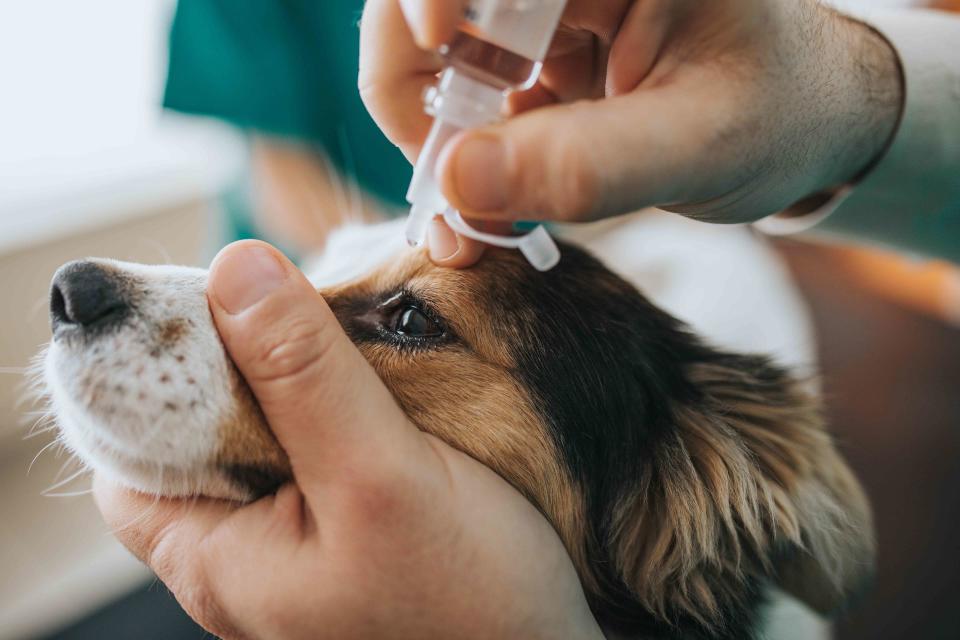Eye Drops For Dogs: Tips For Giving Your Dog Vital Medication
Approach from behind, and don't forget the treats.

skynesher / Getty Images
Reviewed by Juliane Evans
The prospect of administering eye drops for dogs can be daunting, especially if you're dealing with a bigger pup who doesn't like her face being touched. But something like a dog eye infection can force you into action, so you'll want to have a plan and learn how to give your dog eye drops.
Dog eye drops aren't only for those infections. They can help your canine recover from inflammation, abrasions, ulcers, glaucoma, and dry-eye disease, says Kristin Fischer, DVM, DACVO, of Animal Eye Care of the Lowcountry in South Carolina.
Those conditions affect many, many dogs, so you'll want to start getting your dog comfortable with eye drops as soon as you can.
Before You Begin
You can start preparing your dog for eye drops before there are even whispers they might need them. When they're a puppy, make sure you get them used to having their faces touched, Fisher says. It's a process called desensitization.
When you gently clean or pet your dog's face or remove their eye gunk, reward them with a treat—perhaps cheese or peanut butter—so they know the face-touching results in something they enjoy, Fischer says. That'll make your life a lot easier when it comes to eye drops.
Tip
Handling your dog's feet when she's a puppy will get her used to having her nails clipped and wearing boots. The same logic applies to eye drops if you get your dog used to having her face touched.
What You'll Need
This is a pretty short list, but here's what you need to give your dog eye drops:
Medication
An elevated surface (for smaller dogs)
Another set of hands if needed
First, Clean Up
Fischer says dog parents should wash their hands and clean their dogs' faces and eyes before getting to the eye drops. You'll want to clear the eye gunk to make sure the drops get into the eye.
Don't forget to read the instructions on the bottle.
Restrain Your Dog
Have your dog in a confined space and minimize distractions. For smaller or medium-sized dogs, it's best to pick them up and place them on a table or similar surface, Fischer says. You can even wrap them in a towel like a burrito if they're OK with that.
"Trying to chase your dog around and get on their level is sometimes kind of hard," she adds.
For bigger dogs, it's a good idea to lead them to a corner and have them sit down with their backs to you. This is when an extra person might come in handy, someone who can distract the dog as you get ready to drop the medicine in.
Administering the Drops
Stand or sit behind your dog, holding the medication in your dominant hand. Approaching from the front with an unfamiliar object aiming for a dog's eye could cause her to want to back away, which is why Fischer recommends approaching from behind.
Place your free hand under your dog's chin and tilt her head upwards. That will often cause your dog to open her eyes a little wider. You can even place the heel of your dominant hand on the dog's forehead skin and gently pull back, opening the eye even more.
You don't need the eye to be fully exposed, just enough for one drop to clearly descend into the eye.
"You really only need it to go in between the upper and lower eyelids, so you don't have to have this beautiful open eye ball that you're putting the drop directly on," Fischer says.
Remember, you only need one drop of the medication, and if your dog is prescribed multiple drops, wait 10-15 minutes between them. You won't want the second drop washing out the first one.
Finally, reward your dog with a treat for her good job.
Tip
If you're applying eye ointment rather than eye drops, you'll want to apply no more than .25 inches of medicine to the lower eyelid.
Preventing Problems With Your Dog Receiving Eye Drops
For a variety of reasons—past mistreatment, lack of socialization, fear—some dogs don't like having their faces touched, so eye drop time can turn into a wrestling match.
For unruly dogs, you can place a little peanut butter or cheese spread on their nose to distract them from the drops, Fischer says. If your dog bites, Fischer recommends fitting a muzzle over her mouth to protect both of you.
If you're getting nowhere with your dog and her eye drops, consult your veterinarian. Fischer says some dog parents will even bring their pups to the vet's office daily so the staff there can give the dog her drops.
You can also ask about other treatment options like oral medications. Depending on your dog's condition, surgery might be an option, too.
Read the original article on The Spruce Pets.

